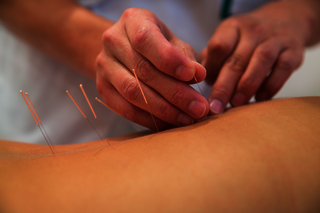Traditional Chinese Medicine (TCM)
Traditional Chinese Medicine (TCM) is based on "five pillars" or five therapy methods that can be used in combination or as individual methods.
These are:
- Acupuncture and moxibustion
- Medicines (usually herbal medicine)
- Qigong and Taiji (read coordination exercises
- Tuina massage
- Nutrition
1st pillar
Acupuncture:
The best-known treatment method is acupuncture, whereby sterile thin needles are inserted into certain points in order to stimulate or influence the life energy, that "QI" as well as the organ energy. This serves to ensure that the "Qi", which can flow harmoniously again in the event of disturbances caused by illness or other complaints, thus eliminating them.
Acupuncture is performed while sitting or lying down so that the patient is relaxed.
When inserting the needles, the patient may feel a slight pain.
Acupuncture not only helps to alleviate the symptoms or illness, but also has a positive effect on the immune system.
In most cases, the needles only stay in the body for a short time, whereas special permanent needles are used for longer-term treatment, which are fixed with a small plaster for up to 10 days. These permanent needles are mainly used in ear acupuncture.
Moxibustion:
With moxibustion, dried mugwort, in the form of a moxa cigar or moxa cone, is held or placed over the point to be treated or additionally placed on the acupuncture needle to conduct the heat into the acupuncture point. This is used, for example, for diseases or symptoms caused by cold
2nd pillar
Medicines:
These are mainly based on medicinal plants and rarely on minerals or animal products, which are usually administered in a complex form. In most cases, teas made from plant extracts, powders or pills are prescribed.
3nd pillar
Quigong and Taiji:
These are special movement sequences in connection with breathing and coordination exercises. In connection with this, they are supposed to direct the Qi, release tension and congestion and thereby give the body rest and support the treatment.
4nd pillar
Tuina massage:
The Tuina massage also stimulates the acupuncture points, combining techniques such as kneading, gripping, tapping and stroking.
5nd pillar
Nutrition:
Diet plays an important role because it allows the patient to contribute to recovery. A healing energetic effect is also attributed to nutrition. A chili pepper or ginger has a warming and sweat-inducing effect, while a yogurt or watermelon has a cooling effect. The dishes also have an effect through their consistency, color and smell. temperature and according to taste, such as bitter, sour, sweet, salty and spicy.
Examples: Spicy on the lungs, sweet on the spleen and pancreas, salty on the kidneys, and sour on the liver.
What is Chinese medicine used for?
The diseases, movement disorders or other discomfort symptoms that can be treated by the therapist can be found in the therapies listed above, osteopathy and kinesiology


